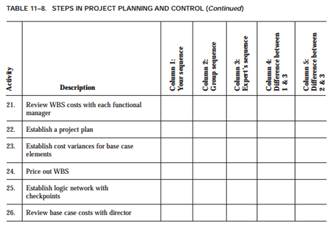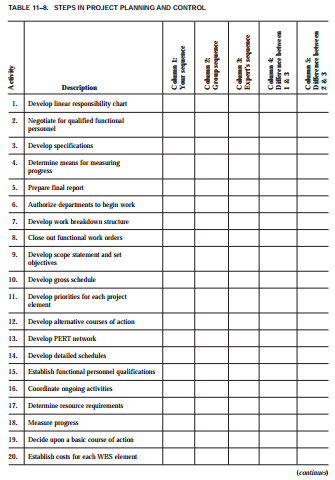Reference no: EM131245013
Table 11-8 identifies twenty-six steps in project planning and control. Below is a description of each of the twenty-six steps. Using this information, fill in columns 1 and 2 (column 2 is a group response). After your instructor provides you with column 3, fill in the remainder of the table
1. Develop the linear responsibility chart. This chart identifies the work breakdown structure and assigns specific authority/responsibility to various individuals as groups in order to be sure that all WBS elements are accounted for. The linear responsibility chart can be prepared with either the titles or names of individuals. Assume that this is prepared after you negotiate for qualified personnel, so that you know either the names or capabilities of those individuals who will be assigned
2. Negotiate for qualified functional personnel. Once the work is decided on, the project manager tries to identify the qualifications for the desired personnel. This then becomes the basis for the negotiation process.
3. Develop specifications. This is one of the four documents needed to initially define the requirements of the project. Assume that these are either performance or material specifications, and are provided to you at the initial planning stage by either the customer or the user.
4. Determine the means for measuring progress. Before the project plan is finalized and project execution can begin, the project manager must identify the means for measuring progress; specifically, what is meant by an out-of-tolerance condition and what are the tolerances/variances/thresholds for each WBS base case element?
5. Prepare the final report. This is the final report to be prepared at the termination of the project.
Table 11-8


6. Authorize departments to begin work. This step authorizes departments to begin the actual execution of the project, not the planning. This step occurs generally after the project plan has been established, finalized, and perhaps even approved by the customer or user group. This is the initiation of the work orders for project implementation.
7. Develop the work breakdown structure. This is one of the four documents required for project definition in the early project planning stage. Assume that WBS is constructed using a bottom-up approach. In other words, the WBS is constructed from the logic network (arrow diagram) and checkpoints which will eventually become the basis for the PERT/CPM charts (see Activity 25).
8. Close out functional work orders. This is where the project manager tries to prevent excessive charging to his project by closing out the functional work orders (i.e., Activity 6) as work terminates. This includes canceling all work orders except those needed to administer the termination of the project and the preparation of the final report.
9. Develop scope statement and set objectives. This is the statement of work and is one of the four documents needed in order to identify the requirements of the project. Usually, the WBS is the structuring of the statement of work.
10. Develop gross schedule. This is the summary or milestone schedule needed at project initiation in order to define the four requirements documents for the project. The gross schedule includes start and end dates (if known), other major milestones, and data items.
11. Develop priorities for each project element. After the base case is identified and alternative courses of action are considered (i.e., contingency planning), the project team performs a sensitivity analysis for each element of the WBS. This may require assigning priorities for each WBS element, and the highest priorities may not necessarily be assigned to elements on the critical path
12. Develop alternative courses of action. Once the base case is known and detailed courses of action (i.e., detailed scheduling) are prepared, project managers conduct "what if" games to develop possible contingency plans.
13. Develop PERT network. This is the finalization of the PERT/CPM network and becomes the basis from which detailed scheduling will be performed. The logic for the PERT network can be conducted earlier in the planning cycle (see Activity 25), but the finalization of the network, together with the time durations, are usually based on who has been (or will be) assigned, and the resulting authority/- responsibility of the individual. In other words, the activity time duration is a function not only of the performance standard, but also of the individual's expertise and authority/ responsibility.
14. Develop detailed schedules. These are the detailed project schedules, and are constructed from the PERT/CPM chart and the capabilities of the assigned individuals.
15. Establish functional personnel qualifications. Once senior management reviews the base case costs and approves the project, the project manager begins the task of conversion from rough to detail planning. This includes identification of the required resources, and then the respective qualifications.
16. Coordinate ongoing activities. These are the ongoing activities for project execution, not project planning. These are the activities that were authorized to begin in Activity 6.
17. Determine resource requirements. After senior management approves the estimated base case costs obtained during rough planning, detailed planning begins by determining the resource requirements, including human resources.
18. Measure progress. As the project team coordinates ongoing activities during project execution, the team monitors progress and prepares status reports.
19. Decide on a basic course of action. Once the project manager obtains the rough cost estimates for each WBS element, the project manager puts together all of the pieces and determines the basic course of action.
20. Establish costs for each WBS element. After deciding on the base case, the project manager establishes the base case cost for each WBS element in order to prepare for the senior management pricing review meeting. These costs are usually the same as those that were provided by the line managers.
21. Review WBS costs with each functional manager. Each functional manager is provided with the WBS and told to determine his role and price out his functional involvement. The project manager then reviews the WBS costs to make sure that everything was accounted for and without duplication of effort.
22. Establish a project plan. This is the final step in detail planning. Following this step, project execution begins. (Disregard the situation where project plan development can be run concurrently with project execution.)
23. Establish cost variances for the base case elements. Once the priorities are known for each base case element, the project manager establishes the allowable cost variances that will be used as a means for measuring progress. Cost reporting is minimum as long as the actual costs remain within these allowable variances.
24. Price out the WBS. This is where the project manager provides each functional manager with the WBS for initial activity pricing.
25. Establish logic network with checkpoints. This is the bottom-up approach that is often used as the basis for developing both the WBS and later the PERT/CPM network.
26. Review base case costs with director. Here the project manager takes the somewhat rough costs obtained during the WBS functional pricing and review and seeks management's approval to begin detail planning